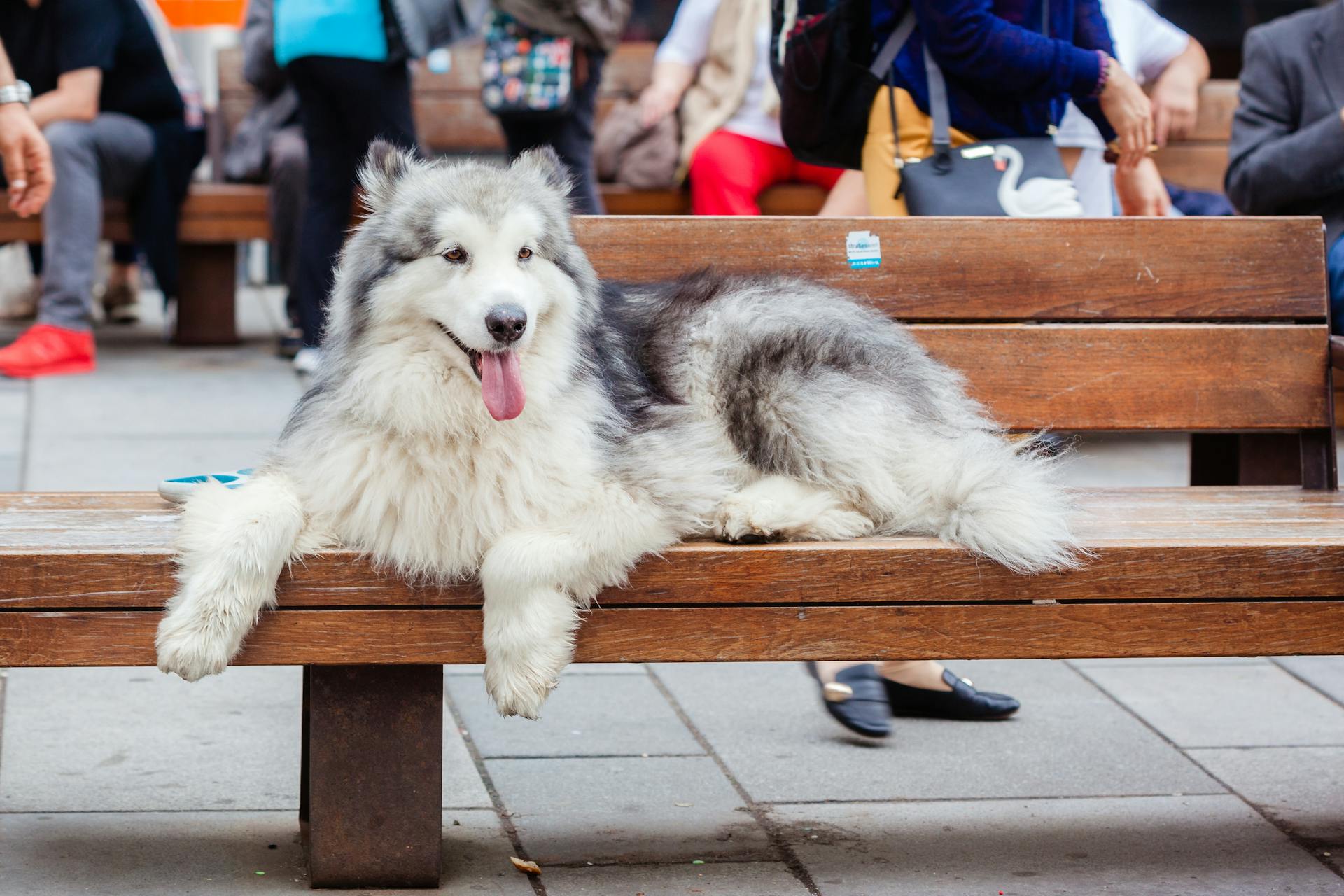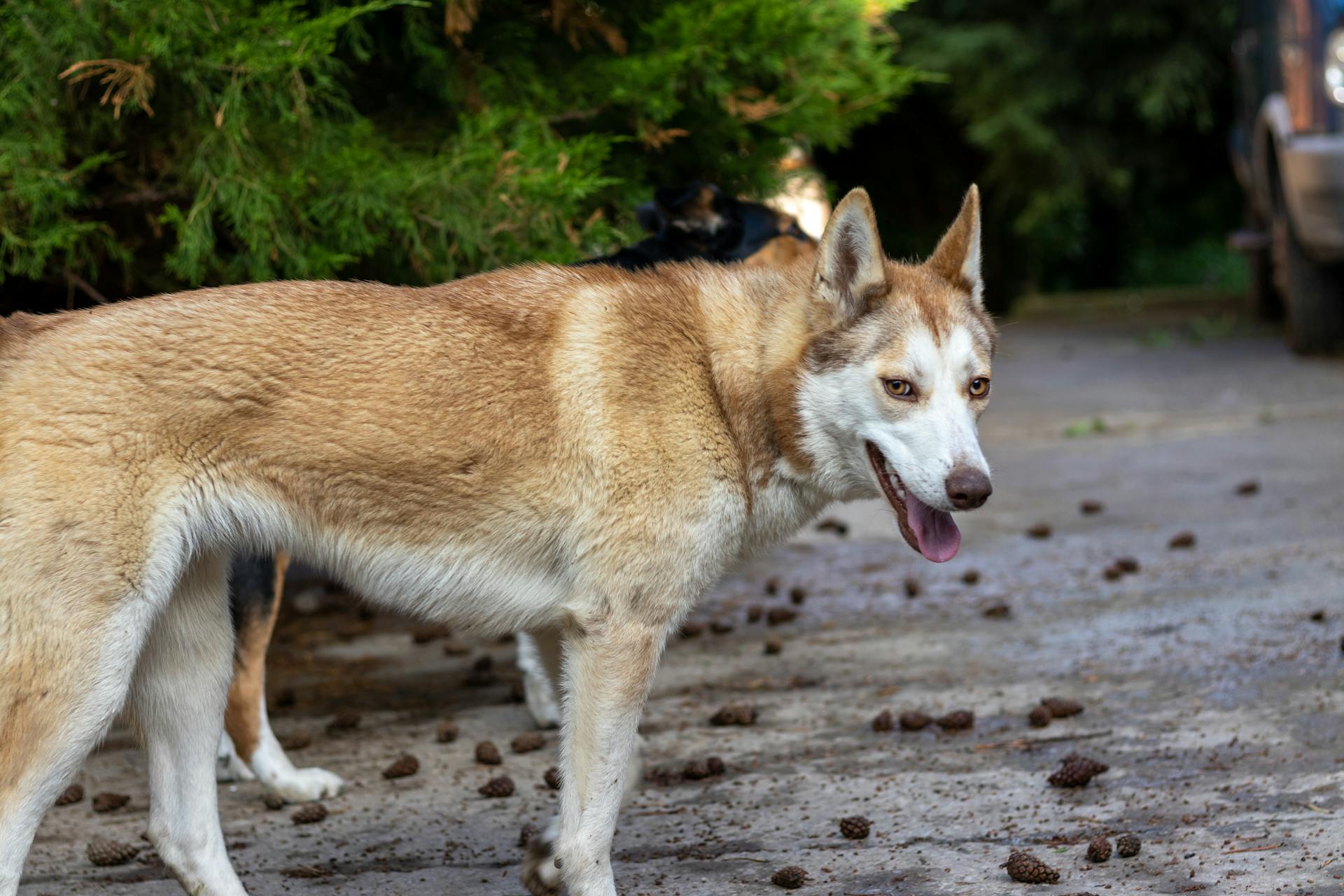
The Brown Alaskan Husky is a unique and captivating breed. They were originally bred to be working dogs, pulling sleds in the harsh Arctic environment.
Their thick double coat is designed to keep them warm in freezing temperatures, with a dense undercoat and a coarser outer coat. This coat requires regular grooming to prevent matting.
In terms of exercise, Brown Alaskan Huskies need plenty of physical activity to stay happy and healthy. A daily run or playtime in a securely fenced area is a must.
Their intelligence and high energy levels make them a great fit for active families or experienced dog owners.
Recommended read: Husky Blowing Coat
Origins
The Alaskan Husky breed is a bit of an enigma, and its origins are still uncertain, with some estimates dating back as far as 12,000 years.
They were originally selected by settlers in North America to obtain dogs with greater performance and resistance in harsh northern conditions.
The Alaskan Husky shares its ancestors with the Siberian Huskies, Alaskan Malamutes, and Nordic breed dogs of the Inuit villages.
They have a short to medium coat, unlike Siberian Huskies, and their color is often dark, grey, or black with brown eyes.
The Alaskan Husky has been selected over time for its agility, powerful musculature, and ability to run fast in the snow and pull heavy weights.
Their slender build makes them perfect for sled dogs, but it also means they require plenty of physical activity to stay healthy.
In fact, without proper exercise, they can quickly become overweight and develop health issues.
Temperament and Training
Brown Alaskan Huskies are highly social dogs that thrive in family settings. They love to play and interact with people, making them great companions for families with kids.
Their sociable nature means they do best in large packs, including humans, and can tolerate fatigue and exhaustion well. They're perfect for families who love the outdoors and enjoy activities like hiking and running.
To ensure a well-rounded personality, early socialization is key. Start socializing your brown husky puppy at an early age, ideally around 8 weeks, to help them become familiar with their environment and people.
Their intelligence and trainability make them a joy to work with, but they can be stubborn at times. Positive reinforcement techniques like praising, playing, and using treats work well with them.
Here are some essential training tips to keep in mind:
Their independent nature means they may have a mind of their own, requiring a firm and consistent pack leader to establish boundaries and maintain control during training sessions. With patience and dedication, you can help your brown husky develop into a loyal companion who loves nothing more than pleasing their owner.
Health and Care
Brown Alaskan Huskies are generally a healthy breed, but they can be prone to eye issues like cataracts and Progressive Retinal Atrophy (PRA), so regular vet checks are a must. They also shed a lot, so be prepared for regular brushing to keep their coat under control.
Their diet plays a crucial role in maintaining their health, so feed them a nutritious and balanced diet, and avoid table scraps or spoiled food. A high-quality kibble, wet food, or a combination of those will keep them healthy and happy.
Regular exercise is essential for Brown Alaskan Huskies, with at least 60 minutes of activity a day keeping them healthy and preventing destructive behavior.
Care Needs

Brown huskies are generally healthy, but they can be prone to eye issues like cataracts and Progressive Retinal Atrophy (PRA). Regular vet check-ups can help catch these issues early.
Regular grooming is essential for brown huskies, as they shed heavily throughout the year. Brushing them several times a week can help keep shedding under control.
A nutritious and balanced diet is crucial for maintaining your brown husky's health. You can choose from high-quality kibble, wet food, raw food, freeze-dried food, or a combination of these.
To keep your brown husky's coat healthy, regular brushing, bathing, and nail trimming are necessary. You should also clean their ears regularly to prevent infections.
Brown huskies need at least 60 minutes of activity a day to stay healthy, which can include running, hiking, or participating in dog sports. Providing a balanced diet with optimum levels of protein and carbs is also essential.
Here's a list of essential care needs for brown huskies:
Brown huskies come in various sizes, ranging from extra small (10kg or less) to extra large (26kg or more). Their size can affect their shedding habits and breeding standards.
Lifespan
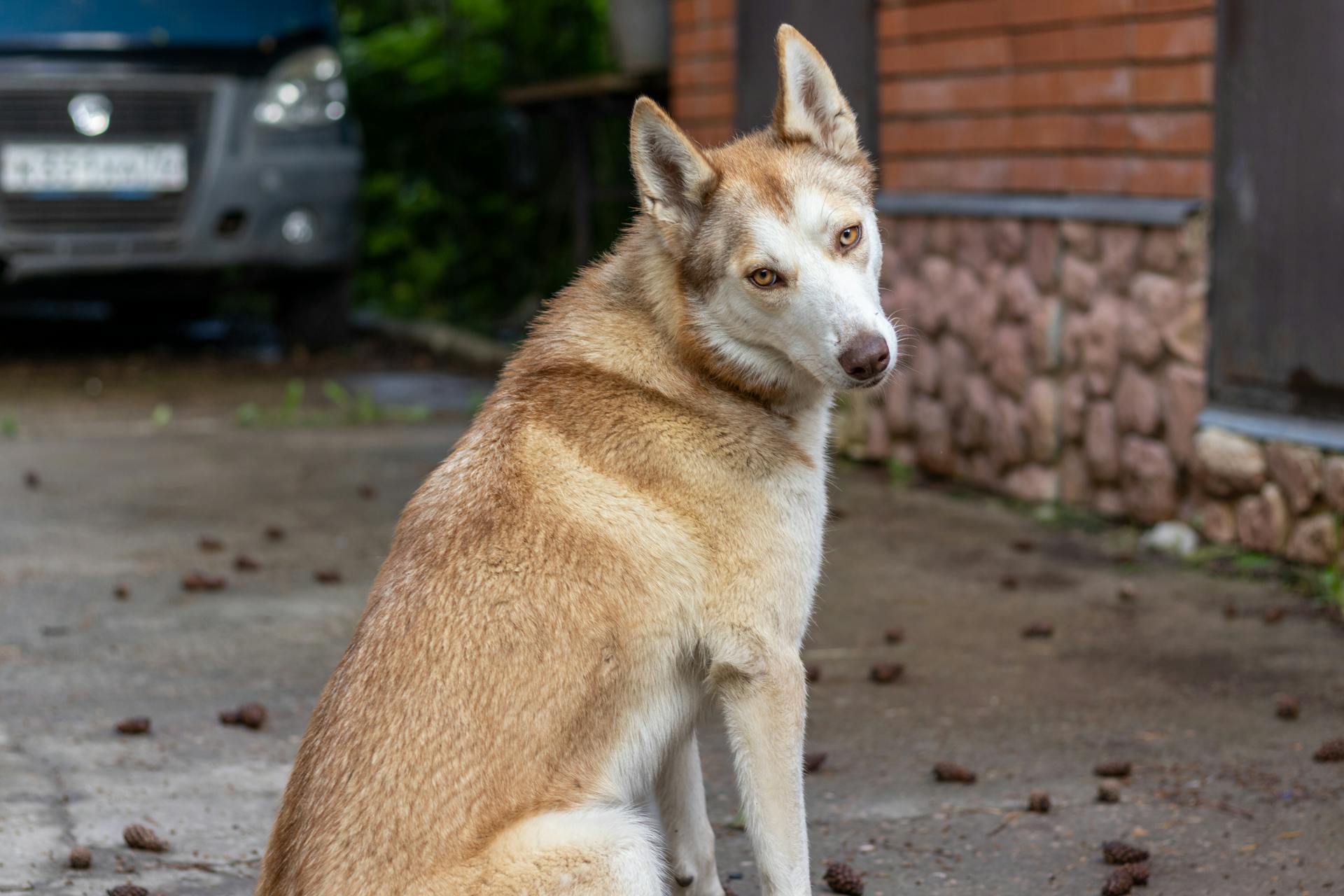
Your Alaskan Husky's lifespan is a significant consideration when it comes to their overall health and well-being.
On average, Alaskan Huskies have a life expectancy of 10 to 15 years.
Larger dogs tend to have a shorter lifespan, which is normal for canines.
Providing your pup with all the basics is crucial to ensuring their lifespan is as long as possible.
Common health problems can shorten your pup's life dramatically, so regular veterinary check-ups are a must.
A poor diet can also have a significant impact on your pup's lifespan, so make sure to feed them a high-quality, balanced diet.
Regular exercise is essential for maintaining your pup's physical and mental health, which can help extend their lifespan.
Intriguing read: What Is the Life Span of a Boston Terrier
Health Issues
Brown Huskies are generally a healthy breed, but they can be prone to certain common ailments. One of the most common problems in this breed is eye issues, such as cataracts and Progressive Retinal Atrophy (PRA).
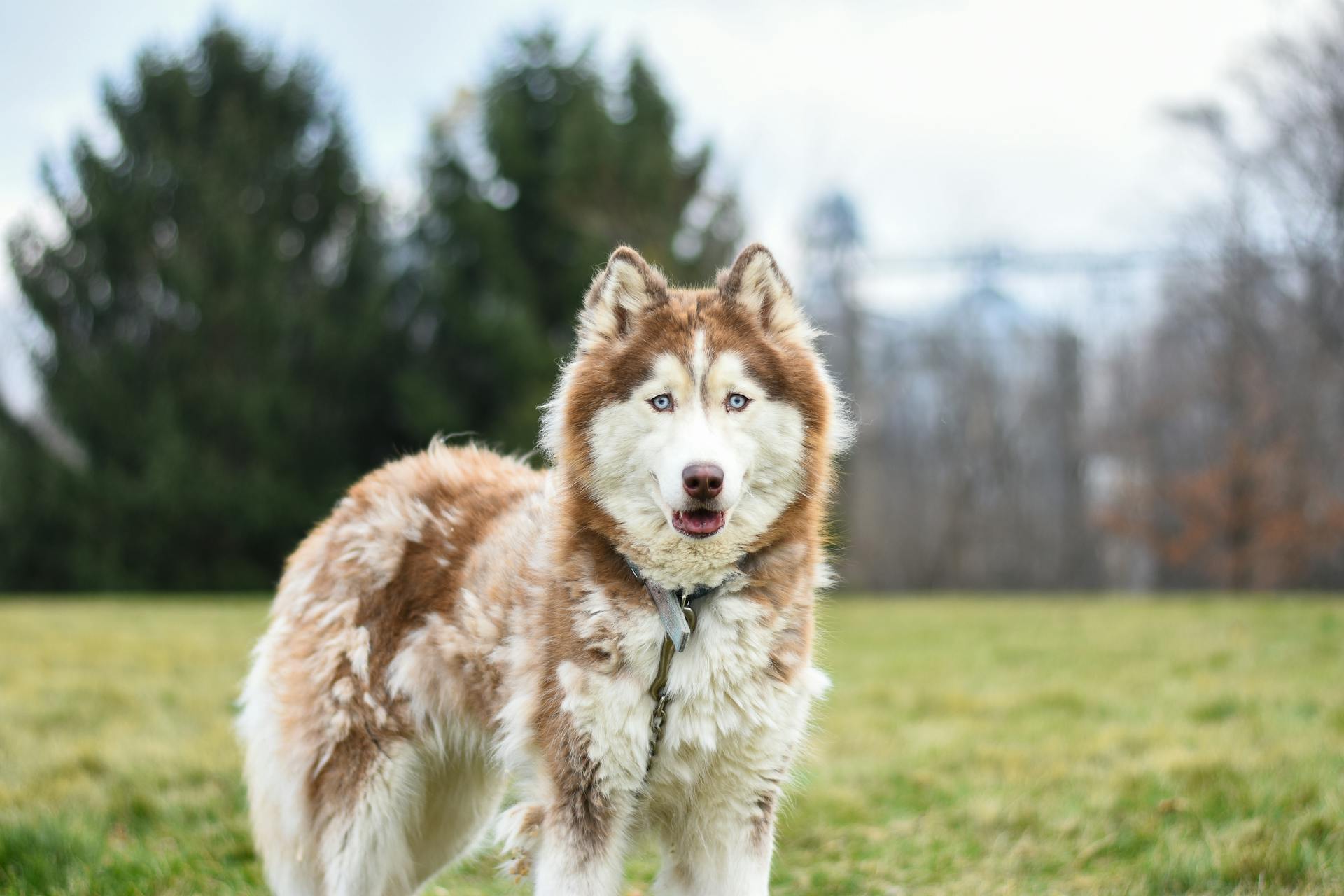
Regular veterinary visits are essential to keep your pup healthy and catch any minor problems before they become more serious. You should have your Husky checked by your vet twice a year for any potential changes to his eyes and vision.
Allergies are another common issue in Brown Huskies, which can cause skin disorders such as rashes or hot spots, inflamed ears, and excessive itching or scratching. Identifying potential allergens and eliminating them from your dog's environment can help manage allergies.
Skin disorders can also arise due to poor nutrition or environmental factors, such as exposure to extreme weather conditions or parasites like fleas or ticks. Signs of a skin disorder include redness, dry patches on the skin, inflammation, and hair loss.
Regular exercise and maintaining a healthy weight can help reduce the risk of hip dysplasia in Alaskan Huskies. Hip dysplasia is a genetic condition that affects the hip joints, causing lameness, pain, and difficulty in movement.
Bathing your Brown Husky every few weeks will help keep their fur shiny and soft while keeping dirt away from harmful skin irritations.
Empty Heading

Brown Huskies are highly social dogs that are friendly with everyone and rarely exhibit reactivity or aggression.
Their high social nature can be beneficial, but it also means they often do poorly with staying by themselves and show increased incidence of separation anxiety.
To combat this, owners can try to provide their Brown Huskies with plenty of exercise and mental stimulation to keep them occupied when left alone.
Brown Huskies also tend to be very vocal, posing a problem for owners living in apartments, as they dislike being confined and can exhibit intense whining in a crate or exercise pen.
In fact, some owners have reported that their Brown Huskies will whine for hours if left in a crate or pen, making it essential to provide alternative solutions.
Alaskan Huskies, on the other hand, are renowned for their exceptional versatility in a wide range of dog sports.
They are not only talented sled dogs but also excel in various other dog-powered activities, showcasing their intelligence, trainability, and remarkable physical abilities.
Their high prey drive also means they tend to run away and make teaching a perfect recall very difficult.
In contrast, Alaskan Huskies are excellent working dogs, known to pull heavy loads to great distances without getting tired.
Dog Socialization
Socialization is key to raising a well-balanced brown Alaskan Husky. They are pack dogs that prefer staying in groups, so it's essential to socialize them early on.
You should start socializing your Alaskan Husky puppy at an early age of puppyhood at eight weeks to ensure that the puppy is familiarized with its environment, including people and other pets. This will boost its confidence and help raise a well-balanced social dog.
Brown Huskies can have an independent streak, so it's crucial to establish boundaries and maintain control during training sessions. A firm and consistent pack leader is necessary to help them understand new commands and tasks.
Here are some essential socialization activities for your brown Alaskan Husky:
- On-leash walks
- Off-leash running in safe, fenced-in areas
- Social exposure (such as at a daycare, walking through the city center etc.)
- Training (obedience, tricks or agility)
- Brain games and food puzzles
Remember, regular socialization is essential to prevent destructive behavior and keep your brown Alaskan Husky happy and healthy.
Breed Overview
The Brown Alaskan Husky breed is a unique and fascinating mix of various Nordic breeds. They are crafted by mixing different breeds into the spitz type husky blood lines, resulting in a medium build and weighing between 35 to 75 pounds.
Alaskan Huskies are known for their affectionate nature and sociable personalities, making them excellent companions. They are intelligent and trainable, but can also have a mind of their own, requiring a firm and consistent pack leader.
Here are some key characteristics of the Brown Alaskan Husky breed:
- They have high energy levels and need plenty of physical exercise to prevent destructive behavior.
- Regular exercise, such as long walks or outdoor activities, is essential to keep them happy and fulfilled.
- They are best suited for active families who can provide ample physical activity and mental stimulation.
Breed Overview
The Alaskan Husky breed is a unique and fascinating mix of various Nordic breeds. They were bred for their working ability, not for looks or pedigree.
These dogs are not purebred, but rather crafted by mixing different breeds into the Spitz type husky bloodlines. Their medium build and weight range of 35 to 75 pounds make them a versatile and agile breed.
Alaskan Huskies are known for their affectionate nature and sociable personalities. They are friendly with people and other dogs, making them excellent companions.
Their high energy levels require regular exercise, such as long walks or outdoor activities, to prevent destructive behavior. With the right care and attention, they can thrive as loyal and loving family pets.
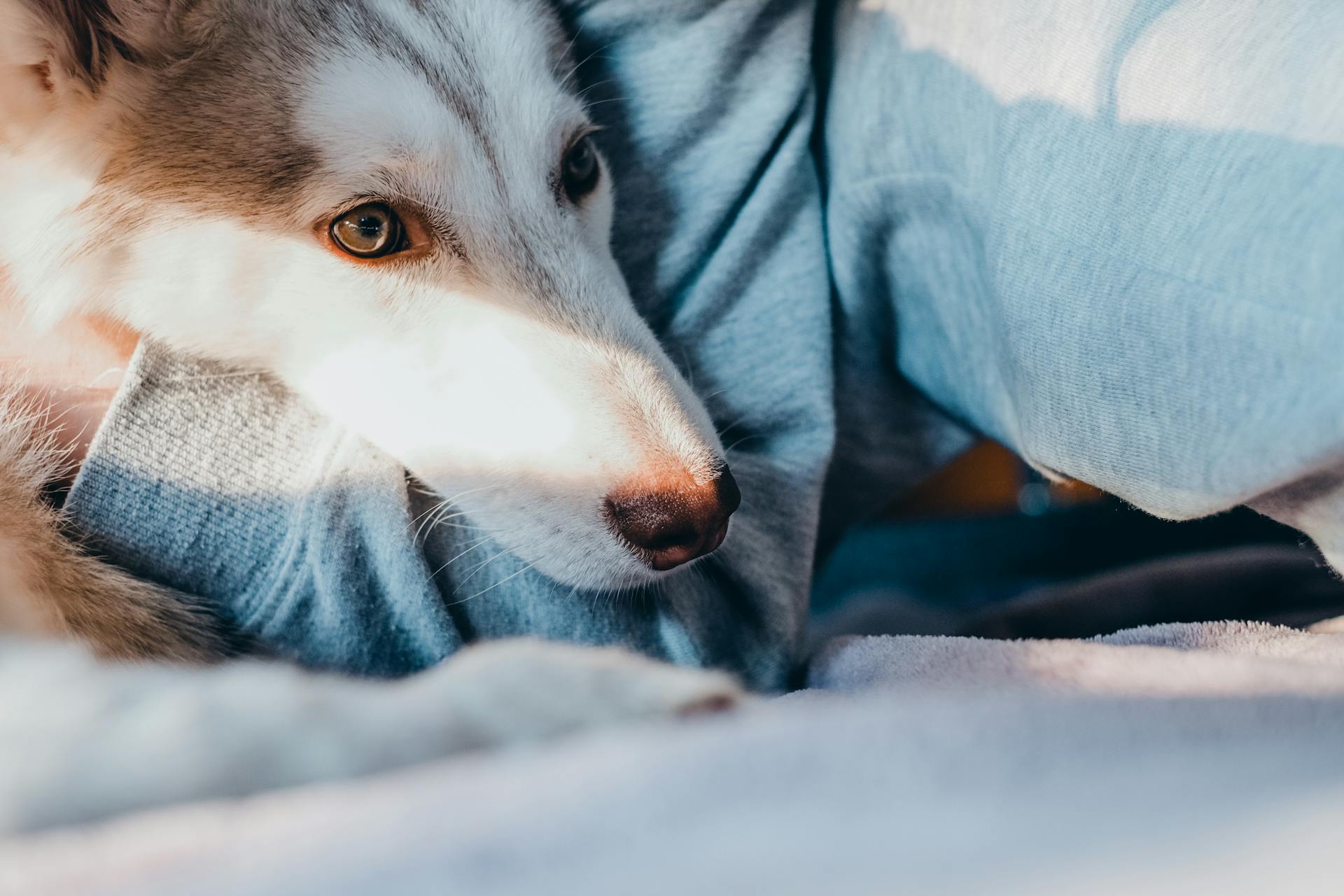
Here are some key characteristics of the Alaskan Husky breed:
- Weight: 35-75 pounds
- Height: 20-25 inches at shoulder height
- Lifespan: 10-15 years
- Coat: Short to medium-length, with a thick double coat
- Eye color: Brown, blue, or a combination of both
Their intelligence and trainability make them a joy to work with, but they can also be stubborn at times, requiring a firm and consistent pack leader. With patience and understanding, they can become loyal and loving companions.
How Big Do They Get?
Alaskan Huskies are a medium to large breed, with a weight range of 35 to 80 pounds. They can vary significantly in size depending on their bloodline, with working dogs tending to be on the larger side.
Their size can also be influenced by their purpose, with racing dogs being leaner and smaller, weighing between 35 and 60 pounds. This is because they're bred for endurance rather than speed or power.
Females are generally smaller than males, but still possess the same energy and strength.
Here's a breakdown of the size variations among brown huskies:
In terms of height, adult Alaskan Huskies typically stand between 20 to 25 inches at shoulder height.
Care and Maintenance
Brown Alaskan Huskies are a relatively healthy breed, but they can be prone to eye issues like cataracts and Progressive Retinal Atrophy (PRA). Regular check-ups with your vet can help catch any potential problems early on.
Shedding is a major issue with all Husky colors, including brown, and requires regular brushing several times a week to get under control. You'll need to commit to a regular brushing routine to prevent shedding from taking over your home.
Feeding your brown Husky a nutritious and balanced diet is crucial for their long-term health and well-being. A high-quality kibble, wet food, raw food, or a combination of those can provide the necessary nutrients.
Socializing your brown Husky is key to helping them feel comfortable around people other than you and those close to you. Introducing them to different environments and people early on can make a big difference.
Regular brushing and bathing are essential for maintaining your brown Husky's coat and overall health. Bathing every few weeks can help keep their fur shiny and soft while preventing dirt from causing skin irritations.
Alaskan Huskies require regular exercise to maintain their physical and mental well-being, so be prepared to be active alongside your furry friend. Running, hiking, or participating in dog sports can help fulfill their need for physical stimulation and tire them out.
Providing a balanced diet with optimum levels of protein and carbs is crucial for your brown Husky's overall health and well-being. Avoid overfeeding to prevent obesity, as these dogs were bred for increased hunger.
Behavior and Training
Brown Alaskan Huskies are highly intelligent and trainable dogs, but they can be notorious escape artists if not properly contained.
They require a lot of exercise and training, and their independent nature means they may take their sweet time or begrudgingly follow commands. Consistency and patience are key during the training process.
Brown Huskies have a strong prey drive, which can make teaching a perfect recall very difficult. They also tend to run away if not properly trained.
Here are some important considerations to keep in mind when training your brown Husky:
- Early socialization is key to ensuring your pup grows up happy and well-mannered.
- Use rewards-based techniques like positive reinforcement, which work especially well with these dogs.
- Start small by teaching basic commands like sit or stay before moving onto more complex behaviors.
Trainability
Alaskan Huskies are highly intelligent dogs that take to training well and can even show signs of great intelligence. They can handle mental stimulation training, but their intelligence can sometimes create problems, like making them notorious escape artists.
Their independent nature means they may take their sweet time or begrudgingly follow commands. Unlike other dogs that live to please, Alaskan Huskies like to think about commands and whether or not they want to do them.
Positive reinforcement techniques are highly effective with Alaskan Huskies, and praising, playing, and using treats can motivate and encourage their learning. They possess a strong work ethic and are quick to understand new commands and tasks.
Early socialization is key to ensuring your Alaskan Husky puppy grows up happy and well-mannered. You can start socializing your puppy at eight weeks to familiarize it with its environment, including people and other pets.
Research has shown that brown Huskies are one of the most trainable breeds in existence, with a success rate as high as 94%. They respond better to treats and rewards rather than hard discipline.
Here are some socializing tips to keep in mind:
- Socializing your pup on regular walks around the neighborhood is essential to help them become accustomed to different sights, sounds, and smells.
- Start directly after you bring your puppy home as a reward-based technique like positive reinforcement works especially well with these dogs.
- Teach basic commands like sit or stay before moving onto more complex behaviors like walking nicely on a leash.
Establishing your authority and having conviction behind your commands can help your dog view you as their pack leader. This can put some of those training issues to rest.
Common Behavioral Issues in Dogs
Alaskan Huskies can be notorious escape artists due to their intelligence and strong will.
Their independent nature means they may take their time following commands or even begrudgingly do what they're told.
This can make training a bit more challenging, especially for inexperienced owners.
Brown Huskies, in particular, have high prey drive and can run away, making perfect recall difficult to teach.
They also tend to be very vocal and may whine intensely in a crate or exercise pen.
Their social nature means they generally get along with other dogs, but proper socialization at a young age is crucial to avoid aggression issues.
Separation anxiety is another common issue in Brown Huskies, as they often do poorly with staying by themselves.
Their strong pack instinct means they prefer staying in groups, which can be beneficial for their socialization and training.
Buying or Adopting
Buying or adopting a brown Alaskan husky is a big decision, and it's essential to consider the costs involved. Prices for buying a brown husky puppy from a breeder can range from $400 to $1000 USD, or even higher for certain bloodlines or colorings.
Adopting from a shelter or rescue group can be a more affordable option, with adoption fees ranging from $50 to $200 USD. This not only saves money but also gives an animal in need a loving home.
Make sure all family members understand the commitment involved in caring for a brown Alaskan husky, including exercise needs, nutrition requirements, and grooming needs. It's also crucial to research what kind of commitment owning this breed entails and determine if now is the right time to bring one home.
Adopting from a shelter or rescue group can be a rewarding experience, both emotionally and financially. It gives animals who deserve loving homes another chance at life.
Frequently Asked Questions
Are brown Huskies rare?
Brown Huskies are less common than black/white Huskies, but not extremely rare. They require a specific genetic combination to express the brown color.
Sources
- https://www.huskyvillage.it/en/huskies/alaskan-husky-dogs-characteristics-and-breeding/
- https://animalcorner.org/dog-breeds/alaskan-husky-a-guide-to-the-hard-working-breed/
- https://spiritdogtraining.com/breeds/brown-husky/
- https://bonevoyagedogrescue.com/brown-husky-dog-breed/
- https://www.boredpanda.com/pet-wellness/dog-breeds/alaskan-husky/
Featured Images: pexels.com

